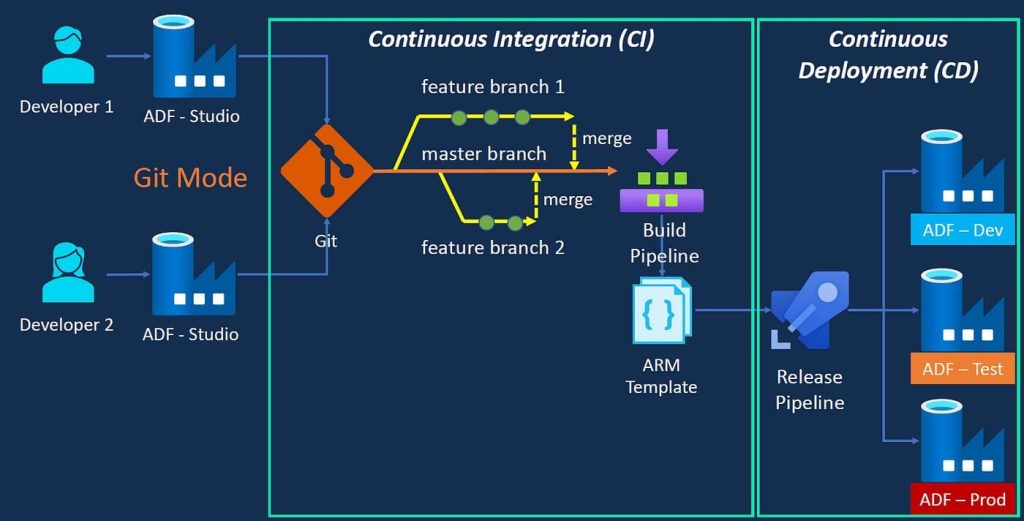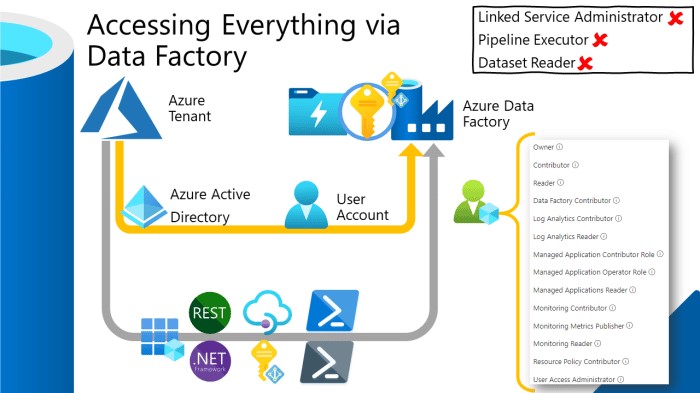In the current data-driven world, companies are sinking in a sea of information. Making sense of this vast ocean requires efficient data pipelines that get the data (Awareness Stage) you need to gather, transform and deliver insights from it. Azure Data Factory (ADF) rises here as a strength tool for automating such pipelines; it simplifies your data integration process and enables decision-making with evidence. Combined automation makes sense in every area. But among so many ADF functions, which one to pick for automation? (Consideration Stage) According to Statista, Microsoft Azure has a market capitalization of $2.31 trillion in 2023.
This blog introduces two popular methods: data flow in ADF with triggers and schedulers—focusing on their advantages will help guide Azure Data Factory Developers (Consideration Stage) as they embark on an automated journey. Feeling the pressure from all of this? Aegis, a team of experienced Azure Data Factory consultants, can help! (Consideration Stage – Encouraging Contact)
Azure Data Factory What’s this about? A Primer on Data Factory
What is azure data factory?

1. The Continuous Integration Approach and (Consideration Stage & Decision Stage)
As a first step into our ongoing series of blogs on the construction of Azure Data Factory pipelines, I would urge you not to jump into the automation techniques just yet. Azure Data Factory (ADF) is a cloud-based ETL (Extract, Transform, Load) besides the data integration facility provided by Microsoft AZURE. More so with Continuous Integration in Data Factory the ability to do non-stop automatic updates without interruption in work or data flow becomes increasingly important (Consideration Stage & Decision Stage). I hope this clears up what is azure data factory.
Leveraging Triggers for Event-Driven Automation (Consideration Stage) –Method 1
Picture a data pipeline that automatically goes into action when something specific occurs. This is the power of triggers to serve as the jubilant listener, starting data pipeline execution when a specified condition is reached. Here are some typical trigger scenarios:
New File Arrived: Want to make sure your data pipeline moves the moment there is new data to process? A trigger can be set to launch the pipeline whenever a new file arrives in a designated storage location (Consideration Stage).
Completion by Schedule: Need to run one pipeline after another pipeline finishes? Trigger-based automation makes this possible, and you have a rippling effect wherein data flows smoothly through your ADF environment (Consideration Stage).
External Events: ADF integrates with various Azure services, allowing triggers to react to external (Cosmos DB record insertion) events. As an example, a trigger could start a data pipeline when new data is added to a Cosmos DB database (Consideration Stage).
Benefits of Trigger-Based Automation:
Real-Time Data Processing: Triggers make sure that your data pipelines react in real-time to events, Keeping your data analysis fresh and its insights up-to-date (Consideration Stage).
Flexibility and Customization: The choices that Triggers offer give you great freedom to create an automation structure that meets your exact needs for data movement (Consideration Stage).
Reduced Operational Load: Triggers release Azure Data Factory developers from the need to manage routine daily pipelines. All new tasks easily fit into those gaps between today’s efficiency improvements (Consideration Stage).
Microsoft’s share in the IaaS market: 23% it will grow a Global quarterly market share of cloud infrastructure services from 2017 to 2023
Method 2: Schedule-based Predictable Automation (Consideration Stage)
For data pipelines that need to be executed at regular intervals, schedulers in ADF provide a dependable solution. Schedulers allow you to set a certain time or frequency for your pipeline to run, ensuring smooth and constant data flow into the hands of analysts. Here are some use cases for schedulers:
Daily Sales Reports: Set up a pipeline to run every day at 12, automatically extract and transform the sales data from yesterday into shape for analysis tomorrow morning. (Consideration Stage)
Weekly Marketing Analytics: Once a week reset the clock on your marketing analytics data, giving insight into how campaigns are doing on more regular basis (Consideration Stage)
Churn analysis by the month: Set up a pipeline that runs regularly to detect churn patterns and trends in customer behavior. This proactive attitude makes the customer more likely to stay loyal.
The Benefits of Using a Scheduler for Automation

Predictable Data Flow: Schedulers ensure that data pipelines run with a defined frequency, providing stable flow and storage facilities (Consideration Stage).
Management Made Simple: Scheduling makes for easy maintenance of data pipelines. This in turn reduces the chance of manual intervention and human error (Consideration Stage).
Reduced Resource Utilization: The fact that pipelines can be programmed to run off-peak automatically means that you can take full advantage of Azure’s resources during less busy periods in which they sit idle otherwise (Consideration Stage).
Choosing the Appropriate Automation Method: Triggers versus Schedulers (Consideration Stage)
The method of automation that is most suitable for your needs depends on the specific nature of your data flow. Here is a brief comparison to help guide you when making this decision (Consideration Stage):
| Feature | Triggers | Schedulers |
| Use Case | Event-driven data processing | Predictable, recurring data processing |
| Trigger Scenario | New file arrival, schedule completion, external events | Daily reports, weekly analytics, monthly churn analysis |
| Benefits | Real-time data processing, flexibility, reduced overhead | Predictable data flow, simplified management, resource optimization |
| Ideal For | Stream processing, reacting to real-time changes | Consistent data availability for analysis |
Beyond the Basics: Advanced Automation Techniques with Aegis (Consideration Stage & Decision Stage)
Beyond a robust foundation created by triggers and schedulers for data flow automation, Azure Data Factory has a range of advanced features. With the help of Aegis, an exceptional group made up entirely of former Azure Data Factory consultants, you will be able to turn these advanced techniques into the best possible way to build your own integrated environment for managing data (Consideration Stage & Decision Stage). For example:
Pipeline chaining: Two or more separate ADF pipelines can be connected together, so what transforms your output into one pipeline then becomes directly fed back into the next. This is particularly beneficial for intricate data operations, and Aegis is going to help you set up smooth and effective inter-pipeline workflows within your data factory (Consideration Stage & Decision Stage).
Dependency management: With dependency management, you can ensure that pipelines only launch when their data sources are accessible. This prevents errors from ever arising and guarantees a smooth passage of data across your ADF environment. Aegis will work with you to configure powerful strategies for dependency management which serve to get the most out of your pipeline (Consideration Stage & Decision Stage).
Integration with Azure Logic Apps: ADF and Azure Logic Apps blend seamlessly, enabling you to kick off data pipelines on the basis of increasingly complex events or workflows. This opens the door to a wider selection of automation scenarios, and Aegis can show you how to mine this integration in order to create a complete plan for automating your data (Consideration Stage & Decision Stage).
The Power of Combining Triggers and Schedulers (Consideration Stage)
Well-rounded automation methods are difficult to apply in most cases. Instead, by automating data processing using ADF, you can build a hybrid whole system of predictable and event-driven processing (Appendix).
Continuous Integration in Data Factory: Ensuring a Smooth Flow of Data (Stage of Decision and Loyalty Phase)
To maintain a Continuous Integration in Data Factory it is particularly essential to implement CI for your data factory. By automating data pipelines with triggers and schedulers, data flows; this also means that newly produced information can be obtained by the analysis process without experiencing further delay or inconsistency (Decision Stage).
Aegis, a team of Azure Data Factory consultants, goes beyond the mere basics in automating data pipelines. We provide you with round-the-clock service to help implement CI in your data factory, by means of such items as
Design and Development of Data Pipelines: Our engineers will work with you in close consultation to understand exactly how your data is flowing at present; thus robust, efficient and most importantly of all – it makes use of the triggers that have been created to automate this process (Decision Stage).
Strategy and Implementation of Automation: Our team will assist you in choosing the most suitable automation techniques for your individual requirements and then install them into the ADF environment, guaranteeing optimal performance (Decision Stage).
Testing and Deployment: Aegis can help you establish a strictly controlled testing routine for your data flows, guaranteeing accuracy and security before network deployment. Additionally, we will assist in the creation of production lines into the system so that it may be made fully operational (Decision Stage).
Monitoring and Maintenance: Run your platform of CI health. A healthy CI environment needs constant monitoring and maintenance. Aegis monitors your data pipelines continuously and solves any problems, and adapts them to fit exactly what you need every step of the way (Loyalty Stage).
Embracing Automation for an Effortless Data Journey (Loyalty Stage)
Leverage Azure Data Factory’s automation to turn your data integration process from an uncomplicated and time-consuming task, into one that takes place automatically and smoothly. With triggers, schedulers, and advanced methods such as piping from one pipeline into another, while preserving dependencies at both ends, you can set up a well-oiled data flow that delivers all of the requested information when it is wanted (Loyalty Stage). To partner with Aegis, your experienced guide in the care and feeding of data, is to unlock the full potential of Azure Data Factory automation. Together, we get rid of your worries about data integration so you can take advantage by making valuable data-driven services (Loyalty Stage).
The Automation Advantage: Which Method is Right for Your Data Flow (Consideration Stage)
In today’s data-obsessed culture, businesses are plastered with information. Getting any value out of it all necessarily means building efficient data pipes to gather, transform, and unpack the data that you asked for (Awareness Stage). Azure Data Factory (ADF) emerges as a strong device to automate these pipes, making your data pipeline more efficient and empowering you to make better decisions based on your data (Consideration Stage). But with triggers and schedulers available at your beck and call, which method is best suited for automated stacking? (Consideration Stage) This blog goes deep into the strengths and considerations of each method, in this way equipping Azure Data Factory developers with the keys to making informed decisions. (Consideration Stage). Feeling overwhelmed? Aegis, a team of seasoned Azure Data Factory consultants, can help! (Consideration Stage – Encouraging Contact)
Trigger versus data flow scheduling in addition to is the primary difference between triggers (separately) Like on A Templates and Schedulers vary in perspective. Here is a summary table of triggers and schedulers’ key features:
| Feature | Triggers | Schedulers |
| Trigger Scenario | New file arrival, schedule completion, external events (database updates, API calls) | Daily reports, weekly analytics, monthly churn analysis |
| Execution | Event-driven, data pipeline runs upon predefined condition | Predefined schedule (daily, hourly, etc.) |
| Benefits | Real-time data processing, flexibility, reduced overhead | Predictable data flow, simplified management, resource optimization |
| Ideal For | Stream processing, reacting to real-time changes | Consistent data availability for analysis |
| Considerations | May require additional logic to handle unexpected events | Might not be suitable for real-time processing needs |
Choosing the Right Method: A Matter of Context (Consideration Stage)
Depending on the specific context of your data flow, the best method for automation varies. Consider these conditions before you make your choice:
Data Latency Requirements: Do you require data to be sent in real-time, or can it wait for a scheduled run? Triggers are suitable in real-time scenarios, while schedulers let it be available constantly at defined intervals.
Data Source Type: Do your data sources change constantly, or do they go by a predetermined schedule? Triggers are ideal for dynamic data sources, while schedulers are good with static or regular data.
Complexity of Data Transformation: Simple transformations can be applied in either place. However, for complex situations, triggers are more flexible to cope with unexpected events when reprocessing.
From Triggers to Schedulers: The Advanced Automation Techniques of Aegis (Decision & Consideration Stages)
Although triggers and schedulers form a sound starting point, ADF goes even further with more advanced automation mechanisms. Even such excellence as the conjunction of powerful tools is not enough. It is necessary to both understand these advanced means and learn how to use them or you can’t optimize your data integration environment properly (Decision Stage & Consideration Stage). Here are some examples:
Orchestrating Complex Workflows: ADF lets you string together several pipelines concurrently. This creates a cascade for complicated data handling. It might cost a lot of CPU time though! Aegis can provide efficient methods for stringing pipelines together within your data factory (Decision Stage & Consideration Stage).
Embrace Automation and Energize Your Data Journey (Loyalty Stage)
By using the complimentary power of Azure Data Factory’s automated facilities to replace manual and time-consuming operations with a system that runs on its own, you can make your data integration comfortable and highly efficient (Loyalty Stage). With Triggers and Schedulers and high-energy ingredients, Create data flows brimming with the info you need. Trust in Aegis, your loyal companion along the information superhighway, to unleash the full potential of automation within Azure Data Factory. We can take part in realizing your seamless data integration. We hope that with your business in full possession of long-awaited data-driven knowledge assets, together we will set out into the future. (Loyalty Stage)
Top 10 Issues concerning Azure Data Factory (AADF) that Are Asked Most Frequently
What is Azure Data Factory (ADF)?
What can it do for me? vs other products like SQL Server, MS Access or SAP Sybase ASE ADF are a cloud-native ETL (Extract, Transform, Load) and data integration service provided by Microsoft Azure. This allows you to shift data from various sources, and transform it into a form where it can be analyzed and loaded into the database warehouse or data lake.
What are the benefits of automating data flow in ADF?
This will help reduce your operational overhead, and improve the manageability of your data center, database systems and storage management. Besides, you can enjoy real-time data processing and predictable data availability.
What are the main methods of automating data flow in ADF?
The two most common methods include triggers and schedulers. Triggers enforce pipelines whenever an event condition is met (new file arrives, external event), while schedulers initiate pipelines at predefined clock times (daily, hourly).
Which method should I use for automation?
The most appropriate method depends on your particular needs and cases. Take into account data latency requirements, behavior of data source systems, and complexity in transformation tasks. Need help making a choice? Aegis, a team of consultants experienced with Azure Data Factory, can provide you with expert support! (Consideration Stage – Encouraging Contact)
What are 3 advanced automation techniques in ADF?
They are: Pipeline chaining for complex workflows, Dependency management ensuring proper order of pipeline execution and Azure Logic Apps from Microsoft to accomplish more sophisticated job descriptions
How can I get started with the automation of data flow within ADF?
A free trial of ADF functionalities is available from Microsoft Azure. Aegis can help you implement and optimize your ADF.
In what ways are Microsoft AADP’s automated data pipelines efficient?
Continual monitoring, improving performance, and assuring data quality management are keystones. For professional support in keeping your data integration environment healthy, consider using a service such as Aegis
How can I guarantee that the data continues to flow smoothly after I have implemented automation of its processes for some time?
By finding the right balance between continuous development philosophies because something is believed to be best at any given time.



